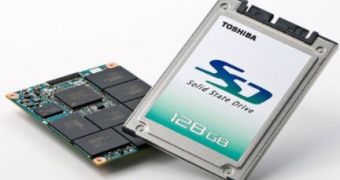Toshiba has recently talked about the future of solid state drives and expressed its optimism about the NAND flash deployment in SSD applications over the next two years. According to industry watchers, the positive outlook the world's second-largest NAND flash memory maker unveiled is rather meant to consolidate the position of its strategic partner flash controller company Phison Electronics and major memory module makers A-Data Technology, Kingston Technology, Power Quotient International (PQI) and Transcend Information at a time when the NAND flash market seems fragile.
During the following few years, SSDs are expected to gain more ground in the market of notebook PC and handheld device applications. Some of the world’s biggest hard disk drive makers, such as Seagate and Western Digital, have already announced their plans to enter the SSD market area with products of their own, as the segment begins to be rather strong and mature. As many of you know, SSDs are reportedly delivering better performance and more reliability than traditional hard disk drives.
Toshiba has recently announced postponing plans to deploy two 12-inch chip plants, but the NAND flash memory player specialist still aims at restoring market confidence by highlighting monthly shipment growth of its SSDs in 2009 and 2010. According to the company, monthly shipments should grow to 100,000 SSDs between April and September next year, while reaching the 600,000 mark by 2010.
The falling NAND flash prices are expected to affect revenue, said Phison, and added that the shipments of NAND flash-related products should climb. The company revealed that its inventory control measures had turned out effectively and that cost and expense cuts should enable a gradual recovery in operating profits. Phison expects its monthly gross margin to rise to double-digit percentages during the fourth quarter, and also estimates that profit will grow on quarter.

 14 DAY TRIAL //
14 DAY TRIAL //